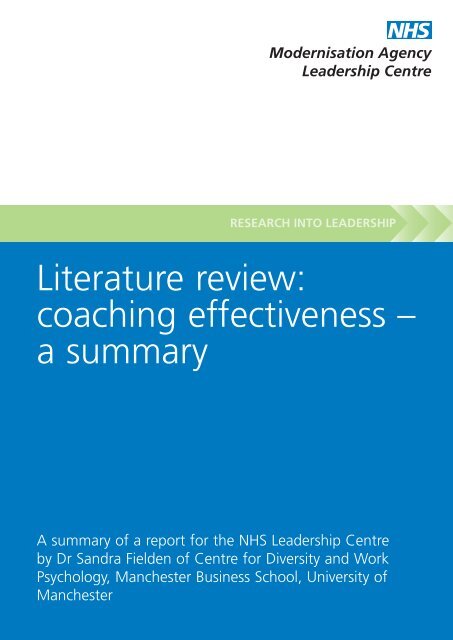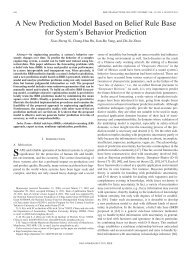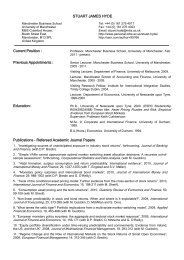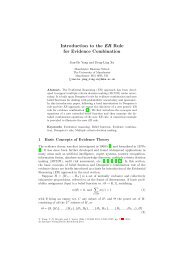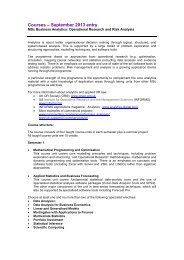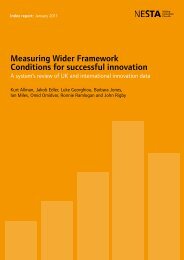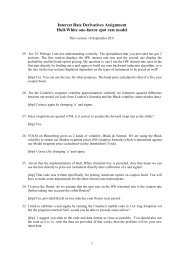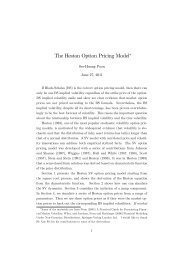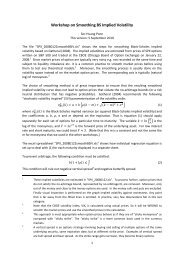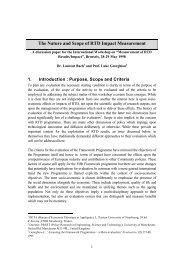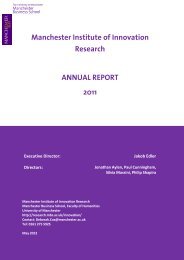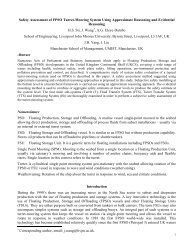Literature review: coaching effectiveness â a summary
Literature review: coaching effectiveness â a summary
Literature review: coaching effectiveness â a summary
Create successful ePaper yourself
Turn your PDF publications into a flip-book with our unique Google optimized e-Paper software.
Modernisation Agency<br />
Leadership Centre<br />
RESEARCH INTO LEADERSHIP<br />
<strong>Literature</strong> <strong>review</strong>:<br />
<strong>coaching</strong> <strong>effectiveness</strong> –<br />
a <strong>summary</strong><br />
A <strong>summary</strong> of a report for the NHS Leadership Centre<br />
by Dr Sandra Fielden of Centre for Diversity and Work<br />
Psychology, Manchester Business School, University of<br />
Manchester
RESEARCH INTO LEADERSHIP<br />
DH Information reader box<br />
Policy<br />
Estates<br />
HR/Workforce Management<br />
Performance IM&T Finance<br />
Planning<br />
Clinical<br />
Partnership working<br />
Document purpose<br />
For information<br />
ROCR ref Gateway ref 4524<br />
Title<br />
Author<br />
<strong>Literature</strong> <strong>review</strong>: <strong>coaching</strong> <strong>effectiveness</strong><br />
– a <strong>summary</strong><br />
NHS Leadership Centre<br />
Publication date March 2005<br />
Target audience<br />
Circulation list<br />
Description<br />
Cross ref<br />
Superseded docs<br />
Action required<br />
Timing<br />
Contact details<br />
Directors of HR<br />
A <strong>summary</strong> of a systematic <strong>review</strong> of<br />
leadership development literature<br />
N/A<br />
N/A<br />
N/A<br />
N/A<br />
Neil Offley<br />
NHS Leadership Centre<br />
5th Floor, 11 Belgrave Road<br />
London SW1V 1RB<br />
0845 607 4646<br />
neil.offley@dh.gsi.gov.uk<br />
For recipients use
Contents<br />
Introduction 2<br />
What is <strong>coaching</strong>? 3<br />
The reasons for the increasing popularity<br />
of <strong>coaching</strong> 4<br />
Coaching and mentoring 5<br />
Being an effective coach 6<br />
Types of <strong>coaching</strong> 7<br />
Selecting a coach 9<br />
Internal versus external 10<br />
Forms of <strong>coaching</strong> delivery 11<br />
The <strong>coaching</strong> relationship 12<br />
A <strong>coaching</strong> model for leadership development 13<br />
Organisational requirements 14<br />
Unsuccessful <strong>coaching</strong> 15<br />
Benefits to organisations 16<br />
Barriers to <strong>coaching</strong> 17<br />
Diversity within <strong>coaching</strong> 18<br />
Summary 19<br />
<strong>Literature</strong> <strong>review</strong>: <strong>coaching</strong> <strong>effectiveness</strong> – a <strong>summary</strong><br />
1
Introduction<br />
This literature <strong>review</strong> demonstrates the importance of<br />
<strong>coaching</strong> relationships and provides practical examples<br />
of how effective <strong>coaching</strong> can be established, ranging<br />
from individual requirements to organisational needs.<br />
However, an extensive <strong>review</strong> of this area has revealed<br />
that there is limited empirical evidence available and<br />
the literature is almost entirely based on authors’<br />
experiences of delivering <strong>coaching</strong> programmes and<br />
their personal and professional experience of <strong>coaching</strong><br />
relationships. Models of <strong>coaching</strong> do not take account<br />
of the diversity inherent in organisations that seek to<br />
employ <strong>coaching</strong> as a management development<br />
strategy. For individuals and organisations to create and<br />
sustain effective <strong>coaching</strong> relationships a wide-ranging<br />
non-linear model is required, which is based on<br />
heterogeneous rather than homogenous methods<br />
of development. Establishing effective <strong>coaching</strong><br />
relationships requires an in-depth examination of the<br />
needs of individuals, as it is necessary to determine<br />
exactly what is required from a <strong>coaching</strong> relationship<br />
in order to ensure that the intervention is designed<br />
effectively and appropriately. Whilst it is essential<br />
to examine the <strong>effectiveness</strong> of <strong>coaching</strong> it is also<br />
equally important to examine dysfunctional <strong>coaching</strong><br />
relationships. Examining the impacts of dysfunctional<br />
relationships will help to highlight where potential<br />
problems can occur and how such problems can<br />
be overcome.<br />
Coaching has a long history, which can be traced back<br />
to Socrates, who believed that individuals learn best<br />
when they have ownership of a situation and take<br />
some form of personal responsibility for the outcome.<br />
In more recent times, <strong>coaching</strong> has played a crucial<br />
role in sports. But the potential of <strong>coaching</strong> as an<br />
organisational development approach has only been<br />
recognised in the last few decades. The NHS Leadership<br />
Centre commissioned this <strong>review</strong> as part of its Research<br />
into Leadership series.<br />
The aim of this literature <strong>review</strong> was to provide a<br />
detailed analysis of the literature and empirical research<br />
addressing <strong>coaching</strong>, with particular focus on the<br />
literature available from the UK. It establishes what is<br />
already known about effective <strong>coaching</strong> and the various<br />
forms of <strong>coaching</strong> currently in operation and provides an<br />
evaluation of these approaches in terms of their success.<br />
The <strong>review</strong> then addresses the requirements for effective<br />
<strong>coaching</strong>, including, the process of <strong>coaching</strong>, the<br />
organisational requirements and the individuals involved.<br />
Finally, a conceptual framework for understanding the<br />
current approaches to <strong>coaching</strong> is presented, with the<br />
gaps in current knowledge highlighted.<br />
2 <strong>Literature</strong> <strong>review</strong>: <strong>coaching</strong> <strong>effectiveness</strong> – a <strong>summary</strong>
What is <strong>coaching</strong>?<br />
A recent CIPD survey of more than 500 respondents<br />
demonstrated that organisations are now moving<br />
away from classroom-based training and placing<br />
increasing importance on other forms of learning and<br />
development, such as <strong>coaching</strong>. The survey highlighted:<br />
• a 51 per cent increase in the use of <strong>coaching</strong> over<br />
the last few years<br />
• a 47 per cent increase of e-learning<br />
• a 42 per cent increase in the use of mentoring and<br />
buddy schemes<br />
• and 96 per cent of respondents agreed that<br />
individuals required advice and support if they were<br />
to take on more responsibility for their own learning.<br />
(Source: Parsloe and Rolph 2004)<br />
Coaching is centred on unlocking a person’s potential<br />
to maximise his or her own performance. A focus on<br />
improving performance and the development of skills<br />
is the key to an effective <strong>coaching</strong> relationship.<br />
There are generally two accepted forms of <strong>coaching</strong>:<br />
directive and non-directive. Directive is a form of<br />
<strong>coaching</strong> whereby the coach teaches and provides<br />
feedback and advice. In contrast, non-directive<br />
<strong>coaching</strong> requires the coach to listen, ask questions,<br />
explore and probe and allows the person coached to<br />
find solutions to problems. In practice, this means that<br />
some coaches merely assert their expertise, whereas<br />
effective coaches enable individuals to go beyond their<br />
previous boundaries.<br />
Coaching can be applied to a variety of areas, such<br />
as motivating staff, delegating, problem solving,<br />
relationship issues, teambuilding, and staff<br />
development. It focuses on what people being<br />
coached want, what their goal is and how they can<br />
achieve it. Coaching is a collaborative relationship<br />
which encourages people to know their values and<br />
live them while achieving their goals. Effective coaches<br />
challenge limiting beliefs and reinforce positive beliefs<br />
by providing tasks followed by feedback.<br />
<strong>Literature</strong> <strong>review</strong>: <strong>coaching</strong> <strong>effectiveness</strong> – a <strong>summary</strong><br />
3
The reasons for the<br />
increasing popularity<br />
of <strong>coaching</strong><br />
Features of the modern organisation, such as flatter<br />
organisational structures and lower job security, often<br />
results in employees, particularly newly promoted<br />
individuals, having to progress and develop quickly,<br />
adjusting to substantial changes in terms of skills and<br />
responsibility (Jarvis, 2004). Coaching can help to<br />
support these individuals, as it has the adaptability and<br />
flexibility to support a range of individuals with different<br />
learning styles. The development needs of individuals are<br />
diverse and the ‘one size fits all’ model of development<br />
is often inappropriate. Thus, <strong>coaching</strong> has the potential<br />
to provide a flexible responsive development approach<br />
that can used to support an increasing number of<br />
individuals within the organisation than traditional<br />
forms of training (Jarvis, 2004).<br />
Over recent years, there has been an increasing trend<br />
of individuals taking greater responsibility for their own<br />
development (Parsloe and Rolph, 2004). If individuals<br />
are to do this they need support and advice and the<br />
<strong>coaching</strong> relationship appears to provide employees<br />
with the appropriate support they need in order to<br />
achieve their developmental aims (Whitmore, 2000).<br />
Individuals are also now demanding different types of<br />
training and development and people tend to be more<br />
motivated when training is increasingly relevant to<br />
their job and responsibilities (Jarvis, 2004). Coaching<br />
focuses on particular work issues and improving job<br />
performance, thus it can be tailored to relevant<br />
aspects of work. Coachees ideally receive direct advice,<br />
assistance and attention which fits with their own time<br />
schedules and objectives and, unlike one off training<br />
activities, <strong>coaching</strong> can provide continuing support for<br />
personal development plans (Jarvis, 2004).<br />
A study conducted by Arnott and Sparrow (2004)<br />
of 1,153 organisations across the UK, found that<br />
organisations used <strong>coaching</strong> for three main reasons:<br />
supporting a strategic initiative, supporting leadership<br />
development, responding directly to individual request.<br />
This is further supported by a recent CIPD Training and<br />
Development survey (2004), which demonstrated that<br />
organisations are now placing increasing importance<br />
on creating and fostering cultures that support learning<br />
and development. Encouragingly, more than 70%<br />
of organisations rated this among the three most<br />
important factors when supporting effective learning.<br />
The survey findings also showed that respondents felt<br />
that it was imperative for line managers to play a<br />
significant role in advising on and supporting<br />
development activity. However, the survey concluded<br />
that 66% of respondents claimed that there was no<br />
formal written strategy for their <strong>coaching</strong> activities<br />
taking place in their organisation, and only 6% claimed<br />
to have one that covered all staff. Furthermore, only<br />
5% claimed to have line mangers who had been<br />
trained to coach their team members, and a worrying<br />
49% only had a minority of trained line managers<br />
which were usually as part of a wider management<br />
training programme. These findings suggest that,<br />
whilst organisations claim to recognise the importance<br />
of <strong>coaching</strong>, they do not necessarily develop the<br />
appropriate culture that is required for <strong>coaching</strong> to<br />
be effective.<br />
4 <strong>Literature</strong> <strong>review</strong>: <strong>coaching</strong> <strong>effectiveness</strong> – a <strong>summary</strong>
Coaching and<br />
mentoring<br />
While the functions of mentoring and <strong>coaching</strong><br />
relationships invariably overlap, they are separate<br />
types of developmental work relationships. Coaching<br />
is directly concerned with the immediate improvement<br />
of performance and skill by a form of tutoring or<br />
instruction. Mentoring is, in effect, one step removed<br />
and is concerned with the longer term acquisition of<br />
skills. Effective <strong>coaching</strong> requires both the coach and<br />
the person coached to fulfil their relative roles. The<br />
degree to which this is achieved depends on a number<br />
of variables, including the experience of both parties<br />
in <strong>coaching</strong> relationships, their interpersonal skills,<br />
motivation and commitment.<br />
Table 1 – Differences between Coaching and Mentoring relationships<br />
Coaching<br />
Relationship generally has a set duration<br />
Generally more structured in nature and meetings<br />
are scheduled on a regular basis<br />
Short term (sometimes time-bounded) and focused<br />
on specific development areas/issues<br />
Coaching is generally not performed on the basis<br />
that the coach needs to have direct experience of<br />
their client’s formal occupational role, unless the<br />
<strong>coaching</strong> is specific and skills focused<br />
Focus is generally on development/issues at work<br />
The agenda is focused on achieving specific and<br />
immediate goals<br />
Coaching revolves more around specific<br />
development areas/issues.<br />
Source: Jarvis (2004: 20)<br />
Mentoring<br />
Ongoing relationship that can last for a long period of<br />
time<br />
Can be more informal and meetings can take place<br />
as and when the mentee needs some advice, guidance<br />
or support<br />
More long-term and takes a broader view of the person<br />
Mentor is usually more experienced and qualified than<br />
the mentee. Often a senior person in the organisation<br />
who can pass on knowledge, experience and open<br />
doors to otherwise out of reach opportunities<br />
Focus is on career and personal development<br />
Agenda is set by the mentee, with the mentors<br />
providing support and guidance to prepare them<br />
for future roles<br />
Mentoring revolves more around developing the<br />
mentee professionally<br />
The main differences between the functions of a coach and a mentor are outlined in the following table:<br />
Table 2 – Comparative Coach and Mentor Roles<br />
Coach<br />
Protégé learning is primarily focused on abilities<br />
Technical or professional focus<br />
Effective use of the protégés existing competencies<br />
Professional interaction with the protégé<br />
Coach usually guides a team<br />
Inspires respect for his/her professional competencies<br />
Short-term training<br />
Source: Benabou and Benabou (2000:2)<br />
Mentor<br />
Learning is focused on attitudes<br />
Technical, professional and political focus<br />
(e.g., introduction into influence networks)<br />
Helps the protégé to realise his/her potential<br />
More interaction with an affective component<br />
Privileged relationship with one person<br />
Is a role model<br />
Long-term development<br />
<strong>Literature</strong> <strong>review</strong>: <strong>coaching</strong> <strong>effectiveness</strong> – a <strong>summary</strong><br />
5
Being an effective<br />
coach<br />
The <strong>coaching</strong> relationship<br />
A coach has several roles to perform. The main<br />
objective is to develop the person being coached. This<br />
can be achieved through increasing self-confidence,<br />
identifying suitable topics for <strong>coaching</strong> and developing<br />
planned tasks as part of job knowledge. Coaching is<br />
not, however, telling someone what to do and how to<br />
do it. Occasionally, it involves overseeing what is being<br />
done and advising how to do it better.<br />
Coaches need to be patient, detached, supportive,<br />
interested, perceptive, aware, self-aware and attentive.<br />
They must also have knowledge, credibility, experience<br />
and authority. They require various core skills: the ability<br />
to create rapport; paying attention to content and<br />
process; keeping an open mind; paraphrasing and<br />
reflecting; asking probing questions; identifying limiting<br />
assumptions and beliefs; and giving and receiving<br />
feedback. However, research shows that coaches feel<br />
it is not necessarily the skills that are important, but<br />
rather the way the skills are used.<br />
Boundaries in <strong>coaching</strong><br />
In the initial stages of the <strong>coaching</strong> relationship it is<br />
imperative that the coach and the coachee establish<br />
boundaries. This requires the coach and coachee to<br />
work together to determine exactly what the <strong>coaching</strong><br />
relationship is and what the objectives are. Research<br />
conducted by Kenton and Moody (2001) found that<br />
there was a mixed response when asking whether<br />
coaches saw a distinction between mentoring,<br />
counselling and <strong>coaching</strong>. Some coaches were very<br />
clear when specifying to their client (coachee) that this<br />
was not to be a counselling relationship, as they did not<br />
have the relevant skills or experience. However, other<br />
coaches stated that they would allow the discussion and<br />
relationship to be directed by the coachee. It is evident<br />
that before a <strong>coaching</strong> relationship begins the coach<br />
and the coachee must establish exactly what is expected<br />
and define the boundaries of the relationship.<br />
Being an effective coachee<br />
People being coached also have an important role to<br />
play in establishing a positive <strong>coaching</strong> relationship.<br />
They must: participate in the identification of suitable<br />
topics for <strong>coaching</strong>; jointly set realistic performance<br />
targets and creative methods of achieving them; take<br />
responsibility for their own development; undertake<br />
comprehensive preparations before <strong>coaching</strong> meetings<br />
to maximise the development process; be open and<br />
direct in discussion with coaches; and accept<br />
constructive feedback on skill acquisition and<br />
development progress.<br />
Benefits to coachees<br />
They can gain a huge amount from an effective<br />
<strong>coaching</strong> relationship. It not only helps to improve<br />
their performance and their effective use of skills and<br />
abilities, but it can also help to increase job satisfaction<br />
and motivation. However, this relationship is not onesided<br />
and has advantages for both parties. There are<br />
many advantages of an effective <strong>coaching</strong> relationship<br />
for the coaches, such as improved communication,<br />
increased staff involvement, more effective delegation<br />
and teams, and higher levels of achievement.<br />
6 <strong>Literature</strong> <strong>review</strong>: <strong>coaching</strong> <strong>effectiveness</strong> – a <strong>summary</strong>
Types of <strong>coaching</strong><br />
There are a number of different approaches to <strong>coaching</strong><br />
that have been developed over the last few years, mainly<br />
derived from the sporting model.<br />
Individual approaches<br />
Goal orientated <strong>coaching</strong><br />
Coaching is an important tool to support organisational<br />
change. When developing strategies to manage change,<br />
<strong>coaching</strong> is now viewed alongside facilitation and<br />
training implementation. Many organisations still believe<br />
that <strong>coaching</strong> is really counselling within the workplace,<br />
although there are many fundamental differences<br />
between counselling and <strong>coaching</strong>. One of the main<br />
differences is the use of goal setting within <strong>coaching</strong>.<br />
Within goal orientated <strong>coaching</strong> there are fundamental<br />
questions that need to be addressed, such as who is<br />
setting the goals, what type of goals are of most value,<br />
how the goals can be achieved and how feedback can<br />
be incorporated.<br />
Executive <strong>coaching</strong><br />
Executive <strong>coaching</strong> is centred on developing fast-track<br />
and high-performing leaders and focuses on technical<br />
issues and psychological considerations. It is based<br />
on the dynamics of being near or at the top of an<br />
organisation and fully recognising the need for<br />
constant improvement. It is important that executives<br />
have a neutral, objective individual with whom they<br />
can discuss opportunities and challenges.<br />
Transactional and transformational <strong>coaching</strong><br />
Coaches need to go beyond the transactional model,<br />
which is primarily concerned with competencies,<br />
learning skills and techniques, and move to a<br />
transformative model, which is focused on shifting<br />
individuals’ views, values and sense of purpose.<br />
There are three core skills for facilitating effective<br />
transformational <strong>coaching</strong> – building awareness,<br />
building commitment and building practice.<br />
Self-<strong>coaching</strong><br />
Self-observation is a fundamental aspect of self<strong>coaching</strong>.<br />
It is necessary for coaches to ask themselves<br />
questions regarding their experience, views, opinions<br />
and beliefs regarding <strong>coaching</strong>.<br />
Team approaches<br />
During times of organisational change, <strong>coaching</strong> can<br />
provide the impetus for building and motivating teams.<br />
Team <strong>coaching</strong> establishes a group of individuals into a<br />
functioning business network. The team is then asked<br />
to brainstorm the options available to them and agree<br />
an action plan formulated by the group. Developing a<br />
set of ground rules which are acceptable to all team<br />
members is vital, because this will ensure that the group<br />
is working to the same agenda. Regular meetings are<br />
needed, and team members may also want to structure<br />
social time together.<br />
The six-step model for team <strong>coaching</strong><br />
Source: (Zeus and Skiffington, 2003: 143)<br />
Step one – management meetings<br />
It is essential that the team coach sets the <strong>coaching</strong><br />
within the context of the organisation’s circumstances,<br />
agenda needs and available resources. To do so, they<br />
must establish with the management team a number<br />
of factors: is team <strong>coaching</strong> an appropriate format, are<br />
there sufficient resources to support this approach, and<br />
is the organisation able to support change? They must<br />
also establish assessment, benchmarking, reporting<br />
and feedback procedures. The size of the team is also<br />
important, with six to eight the preferred number.<br />
Step two – individual meetings with each<br />
team member<br />
An individual briefing session of 20-30 minutes with<br />
each team member can enable the coach to allay any<br />
fears or reservations, hostile behaviour or barriers.<br />
Step three – first team meeting<br />
During the first team meeting, it is essential that the<br />
coach fosters a culture of trust, and openness. The<br />
coach needs to define his/her role and set objectives<br />
for the <strong>coaching</strong> sessions.<br />
Step four – second meeting<br />
The coach should provide feedback from assessment,<br />
and <strong>review</strong> and encourage the commitment of the<br />
team to the agreed visions and goals, and explore<br />
any resistance to proposed goals.<br />
Step five – begin formal <strong>coaching</strong> sessions<br />
The workshop format is regarded as the most effective.<br />
These workshops will include groups of six to eight<br />
(one coach) or 10 to 12 (two coaches).<br />
<strong>Literature</strong> <strong>review</strong>: <strong>coaching</strong> <strong>effectiveness</strong> – a <strong>summary</strong><br />
7
Step six – management feedback<br />
The performance and progress of the team needs to be<br />
regularly <strong>review</strong>ed, and management feedback provided<br />
as agreed.<br />
The 14-step process to team <strong>coaching</strong><br />
Many organisations and their leaders face a dilemma<br />
– they need to build effective teams, but the time<br />
available to build such teams is decreasing. A parallel<br />
approach to building effective teams has been shown<br />
to enable leaders to build teams without wasting time.<br />
In essence, the process revolves around identifying<br />
behavioural changes and implementing them, with<br />
monthly progress reports. The 14-step process model<br />
can be found in the full report.<br />
8 <strong>Literature</strong> <strong>review</strong>: <strong>coaching</strong> <strong>effectiveness</strong> – a <strong>summary</strong>
Selecting a coach<br />
One study (Arnott & Sparrow 2004) found a number<br />
of selection criteria for choosing a coach, including<br />
<strong>coaching</strong> experience, track record, personal style,<br />
culture fit, structured approach, costs, professional<br />
standards, knowledge of organisation, issue fit,<br />
evidence of CPD, line management experience,<br />
experience of the industry, <strong>coaching</strong> qualifications,<br />
scalability, supervision of coach, presentation and<br />
materials, and geographic coverage. The study also<br />
found that building an effective <strong>coaching</strong> relationship<br />
rested on hard factors, such as expertise, and soft<br />
factors, such as trust and relationship fit.<br />
When deciding on a coach, the organisation and<br />
the person coached must assess the individual’s<br />
development needs and, from this, develop a desired<br />
coach profile that will include both organisational and<br />
individual requirements. A shortlist followed by<br />
interviews will give the person to be coached some<br />
insight into the coach’s experience and skills. The<br />
matching of individuals in a <strong>coaching</strong> relationship<br />
is critical to its success. [Source: Jarvis 2004]<br />
<strong>Literature</strong> <strong>review</strong>: <strong>coaching</strong> <strong>effectiveness</strong> – a <strong>summary</strong><br />
9
Internal versus external<br />
The <strong>coaching</strong> process can support a key facet of<br />
leadership – the requirement to be engaging beyond<br />
the boundaries of the organisation. However, an<br />
organisation that simply views <strong>coaching</strong> and particularly<br />
executive <strong>coaching</strong> as a process provided by external<br />
consultants can have problems when attempting to<br />
establish a climate of leadership. Today’s leaders must<br />
not set themselves apart from the rest of the<br />
organisation but should seek to replicate their best<br />
leadership practices and behaviours in those working<br />
around them. A coach internal to the organisation does<br />
not require any learning curve to absorb and<br />
understand the culture.<br />
Two international studies, however, provide empirical<br />
support for the use of an external coach and have<br />
demonstrated that self-<strong>coaching</strong> achieves greater<br />
performance compared with peer <strong>coaching</strong>. They<br />
concluded that an external coach was superior and the<br />
findings highlighted the importance of <strong>coaching</strong> by a<br />
credible source.<br />
Yet another study suggests that internal coaches are<br />
superior when a quick intervention is needed and when<br />
detailed knowledge of the corporate culture is required.<br />
External coaches are most effective when there are<br />
highly sensitive or confidential issues that need to be<br />
addressed within the relationship, or when extensive or<br />
diverse experience is required.<br />
Table 3 – External and internal coaches<br />
External coaches are preferable:<br />
For providing sensitive feedback to senior business<br />
leaders. For political reasons, this can be difficult for<br />
an internal coach<br />
For bringing specialised expertise from a wide variety<br />
of organisational and industry situations<br />
When an individuals are concerned about ‘conflict of<br />
interests’ and whether confidentiality will be observed<br />
For providing a wider range of ideas and experience<br />
For being less likely to judge and being perceived<br />
as more objective<br />
Source: Jarvis (2004: 45)<br />
Internal coaches are preferable:<br />
When knowing the company culture, history<br />
and politics is critical<br />
When easy availability is desired<br />
For being able to build up a high level of personal<br />
trust over a period of time<br />
For not being seen to be ‘selling’ consulting time<br />
For keeping costs under control – and may be<br />
less expensive<br />
10 <strong>Literature</strong> <strong>review</strong>: <strong>coaching</strong> <strong>effectiveness</strong> – a <strong>summary</strong>
Forms of <strong>coaching</strong><br />
delivery<br />
Coaching can be delivered in numerous forms, such as<br />
face to face, via telephone and online.<br />
Face-to-face <strong>coaching</strong><br />
This is the traditional form of <strong>coaching</strong> delivery,<br />
reminding both parties that words are only one aspect<br />
of communication. Unspoken issues can be accessed<br />
through a face-to-face encounter, for example through<br />
body language. However, there can be disadvantages.<br />
This form of <strong>coaching</strong> can be immensely impractical<br />
when considering busy schedules and locations.<br />
Telephone <strong>coaching</strong><br />
Telephone <strong>coaching</strong> is now used extensively. It is more<br />
cost effective for the client/coached as they only have<br />
to pay for the focused <strong>coaching</strong> session and not for<br />
travelling. However, there is a loss of appearance,<br />
facial expressions and gesticulations when conducting<br />
telephone <strong>coaching</strong>. One researcher believes individuals<br />
communicate at about 40 per cent of their ability<br />
when on the telephone because facial expressions and<br />
gesticulations cannot be seen. However, anecdotal<br />
evidence has suggested that people find other ways of<br />
communicating effectively, for example by using vivid<br />
descriptive language. Telephone <strong>coaching</strong> also enables<br />
individuals to become much more effective listeners.<br />
Online <strong>coaching</strong><br />
There are many advantages to online <strong>coaching</strong>, such<br />
as cost and time savings and increased flexibility<br />
when choosing the time for learning. It can all be<br />
organised through email, discussion groups, chat rooms<br />
and visual tutorials. It is essential that organisations<br />
have a strategy for e-learning to ensure that online<br />
<strong>coaching</strong> is effectively implemented. Creating a learning<br />
environment is important. Many organisations find the<br />
best way to motivate employees and achieve the best<br />
results is by enabling learners to choose where and<br />
how they learn. Programmes such as e-<strong>coaching</strong> are<br />
more widely accepted when the organisation has a<br />
culture of trust and empowerment. In a command and<br />
control style culture, managers do not feel comfortable<br />
allowing employees to use the internet freely and<br />
organise their own work schedules, responsibilities,<br />
learning and development.<br />
<strong>Literature</strong> <strong>review</strong>: <strong>coaching</strong> <strong>effectiveness</strong> – a <strong>summary</strong><br />
11
The <strong>coaching</strong><br />
relationship<br />
Phases of <strong>coaching</strong><br />
In general, the process of <strong>coaching</strong> includes four distinct<br />
phases. Firstly, the coach and coachee must establish<br />
some form of contract. Secondly, action plans need to<br />
be formulated so to ensure that the coachee is meeting<br />
their objectives. Thirdly, live action where the coach<br />
and coachee begin the <strong>coaching</strong> process and finally,<br />
debriefing, whereby the coach and coachee reflect on<br />
performance and evaluate <strong>effectiveness</strong>.<br />
The <strong>coaching</strong> structure<br />
A <strong>coaching</strong> structure has been developed that<br />
demonstrates how the coach and coachee work<br />
together throughout the <strong>coaching</strong> process, exploring<br />
not only tasks but attitudes and behaviours. The use<br />
of a structure provides a clear direction for the <strong>coaching</strong><br />
relationship and the various tasks and objectives which<br />
need to be achieved at each distinct stage.<br />
Belonging<br />
The focus here is on whether the person being coached<br />
feels the coach is sufficiently ‘like’ him or her.<br />
Controlling<br />
In a one-to-one <strong>coaching</strong> relationship, the control needs<br />
are less intense than they would be in a group. But they<br />
still make an appearance. Having some form of control<br />
enables an individual to feel competent and able to deal<br />
with responsibilities. So it is important that there is a<br />
sense of ‘power-sharing’ in the <strong>coaching</strong> relationship.<br />
Closeness<br />
Coaches must consider whether they prefer to have<br />
‘close and personal’ relationships or to keep some<br />
distance.<br />
The <strong>coaching</strong> framework<br />
A framework has been developed which further<br />
explains the various elements of the <strong>coaching</strong> process<br />
and <strong>coaching</strong> relationship. The model is primarily nondirective,<br />
whereby the coachee/client has the potential<br />
to achieve more and takes responsibility for their own<br />
actions. It provides the coach and coachee with a<br />
toolkit and structure which can be applied to any<br />
individual <strong>coaching</strong> relationship. The framework can<br />
be found in the full report.<br />
The phases, structure and framework provide the<br />
coach and the coachee with direction to ensure that<br />
the <strong>coaching</strong> relationship is both effective and efficient.<br />
Ensuring that the <strong>coaching</strong> relationship is based on<br />
effective communication and commitment will help the<br />
two parties to understand the key objectives of the<br />
relationship. It is important to understand the needs of<br />
both individuals in the <strong>coaching</strong> relationship before it<br />
begins. One study by Hardingham et al (2004) identifies<br />
three types of social needs that should be noted and<br />
attended to in order to ensure that the <strong>coaching</strong><br />
relationship is effective:<br />
12 <strong>Literature</strong> <strong>review</strong>: <strong>coaching</strong> <strong>effectiveness</strong> – a <strong>summary</strong>
A <strong>coaching</strong> model for<br />
leadership development<br />
Developing leaders and their capabilities is crucial in<br />
any organisation. There is a wealth of literature<br />
pertaining to the desired personal attributes of a leader,<br />
various leadership style, and the competencies, skills<br />
and abilities of an effective leader. The framework<br />
advocated by Goldsmith et al (2000) is modelled on<br />
the cycle of continuous improvement, where the coach<br />
assists and supports a leader through the process of<br />
development, once the coach believes that the leader<br />
has an understanding of the process and the cycle<br />
of continuous improvement the coach will allow the<br />
leader to take full responsibility with regard to their<br />
development. However, as with many of the models<br />
and frameworks outlined in this <strong>review</strong>, it is not based<br />
on empirical research but on consultancy experience.<br />
Although the model does advocate the assessment of<br />
leadership skills and then basing the development<br />
plan on these skills and competencies, it does not<br />
clearly illustrate the different approaches which need<br />
to be taken when accounting for differences in<br />
leadership styles.<br />
There are four phases:<br />
Assessment: leadership skills are assessed to obtain a<br />
benchmark of current leadership abilities to determine<br />
whether progress has been made.<br />
Developmental plan: the leader chooses focus areas<br />
and the goals to be achieved. The coach assists the<br />
leader, particularly if the leader receives feedback he/she<br />
does not agree with. The coach provides validation,<br />
support and ‘tough love’.<br />
Public announcement: making the goals public. This<br />
increases the leader’s commitment to the announced<br />
course of action, and it lays a foundation for follow-up<br />
conversations with observers on the progress towards<br />
the goal.<br />
Implementation: comprised of developmental activities<br />
and informal follow-up. The coach may take on the role<br />
of tutor and provide useful tools and tips to enable the<br />
leader to achieve the developmental goals. A culture<br />
of continuous leadership development begins, with<br />
informal feedback every couple of months in an<br />
informal conversation. Finally, the leader begins the<br />
cycle once again with another assessment process. The<br />
results are <strong>review</strong>ed and the coach must encourage the<br />
leader to identify new areas that require development.<br />
(Source: Thach and Heinselman (2000: 224))<br />
There is a wealth of research and literature relating<br />
to gender differences in leadership styles and the<br />
evidence suggests that female leaders tend to be more<br />
transformational, whereas male leaders take a more<br />
transactional approach (Alimo-Metcalfe, 1994). In<br />
contrast, there is a dearth of research examining gender<br />
differences and <strong>coaching</strong>. It is widely acknowledged that<br />
men and women have different learning and leadership<br />
styles and therefore, this needs to be understood when<br />
embarking on a <strong>coaching</strong> relationship.<br />
<strong>Literature</strong> <strong>review</strong>: <strong>coaching</strong> <strong>effectiveness</strong> – a <strong>summary</strong><br />
13
Organisational<br />
requirements<br />
For effective <strong>coaching</strong> to be achieved, organisations<br />
must foster a culture that supports this relationship.<br />
There needs to be a clear strategy and focus on how<br />
effective <strong>coaching</strong> can be achieved. This strategy must<br />
be understood and adopted by all staff at all levels.<br />
The organisation needs to be aligned to the success<br />
of the <strong>coaching</strong> process.<br />
A recent survey demonstrated that organisations<br />
were now placing increasing importance on creating<br />
and fostering cultures that support learning and<br />
development. More than 70 per cent of organisations<br />
rate this among the three most important factors when<br />
supporting effective learning. The survey findings also<br />
showed that respondents felt it was imperative for line<br />
managers to play a significant role in supporting<br />
development activity. However, the survey concluded<br />
that 66 per cent of respondents claimed there was no<br />
formal written strategy for their <strong>coaching</strong> activities<br />
taking place and only six per cent claimed to have one<br />
that covered all staff. Furthermore, only five per cent<br />
claimed to have line managers who had been trained to<br />
coach their team members, whereas a worrying 49 per<br />
cent only had a minority of trained line managers.<br />
There are several ways of establishing a <strong>coaching</strong><br />
culture. One study lists a number of tips, such as<br />
building experience of, and a belief in, <strong>coaching</strong> among<br />
leaders of the organisation. This may be achieved, for<br />
example, by ensuring that the leadership/executive team<br />
members receive <strong>coaching</strong> themselves. Employees and<br />
employers should be motivated to talk about <strong>coaching</strong><br />
and their experiences and how it has helped them<br />
achieve their goals. It is important that the leaders in<br />
an organisation clarify exactly what a ‘<strong>coaching</strong> culture’<br />
actually is, for example what would people be saying<br />
and doing that they are not doing now?<br />
Culture alignment<br />
In order to foster a culture of <strong>coaching</strong>, it is essential<br />
that the organisation is aligned to the success of the<br />
<strong>coaching</strong> process (Whitmore, 2002). The organisation<br />
must be supportive of the process and provide the<br />
necessary support and resources required to ensure<br />
that the <strong>coaching</strong> intervention is successful (Zeus and<br />
Skiffington, 2003). This is further enhanced by the<br />
role of the coach, who ensures there is support and<br />
enthusiasm for <strong>coaching</strong> within the organisation.<br />
Blending training with <strong>coaching</strong><br />
Blending training with <strong>coaching</strong> is particularly important<br />
and can produce very powerful results. Using a mix of<br />
training and <strong>coaching</strong> can be particularly useful when<br />
an organisation is going through change because it<br />
can help individuals to change their behaviour and<br />
leadership styles.<br />
Individual coach/coachee<br />
requirements<br />
The success of a <strong>coaching</strong> relationship/intervention is<br />
dependent, to a certain extent, on whether or not the<br />
stated goals have been achieved (Zeus and Skiffington,<br />
2003). It is essential during the initial stages of the<br />
<strong>coaching</strong> process to establish how the coachee defines<br />
success. The coach must also make it clear from the<br />
outset his or her expertise, for example, they may not<br />
necessarily be an expert who provides answers to<br />
questions, but an individual who provides support,<br />
direction, guidance encouragement and resources,<br />
whose function is to inspire and evoke answers from<br />
the coachee. It is essential that the coach clearly states<br />
his or her limitations (Edwards, 2003). It is also<br />
imperative that the coach does not respond to selfimposed<br />
or perceived pressure from the coachee and<br />
their organisation to achieve quick results. Coaching<br />
is centred on change and change can often be slow,<br />
difficult and at times resisted, therefore the coach<br />
may need to educate the coachee and indeed the<br />
organisation. Perhaps the most critical problem in<br />
<strong>coaching</strong> relationships identified in the literature<br />
is that the coach and/or coachee may be lacking<br />
in self-awareness.<br />
Coaching is centred on change, and change involves<br />
learning. It is essential that the coach is aware of the<br />
level of confidence in the person being coached and<br />
his/her fears regarding new learning opportunities and<br />
challenges. Challenges that seem too great can result<br />
in anxiety, which can ultimately lead to resistance.<br />
14 <strong>Literature</strong> <strong>review</strong>: <strong>coaching</strong> <strong>effectiveness</strong> – a <strong>summary</strong>
Unsuccessful <strong>coaching</strong><br />
An effective coach draws on his/her experience to<br />
accelerate individual learning and development. A coach<br />
can help unlock potential and maximise performance.<br />
The person being coached may define success by: how<br />
he/she is stimulated to think, feel and explore new<br />
attitudes; whether the coach provides a supportive<br />
relationship; the coach’s ability to provide resources and<br />
expertise from industry experience; the coach’s skill in<br />
encouraging a resistance to change; and how the coach<br />
deals with paradox and contradictions.<br />
The literature tends to focus on 'successful' <strong>coaching</strong><br />
relationships but little is known about unsuccessful<br />
<strong>coaching</strong> relationships and the detrimental effect these<br />
can have. Coaching sessions can prove to be unhelpful<br />
for both parties.<br />
Coaching may fail for a number of reasons:<br />
• The coach may have a tendency to prescribe<br />
simplistic solutions to complex organisational or<br />
life/balance issues. (This can be avoided if the coach<br />
makes his/her expertise clear from the outset and<br />
explains that he/she may not be an expert giving<br />
answers but an individual who provides support,<br />
encouragement and resources.)<br />
• People being coached may have major interpersonal<br />
difficulties. (It is essential for the coach to determine<br />
at the outset why this relationship is unproductive.<br />
The reason may be, for example, the <strong>coaching</strong> style.)<br />
• The coach may share his/her opinion too early.<br />
(Coaches need to remember that <strong>coaching</strong> is 80 per<br />
cent listening and 20 per cent talking.)<br />
• The coach may fail to follow through on monitoring<br />
and homework. (It is vital that the monitoring process<br />
is established at the start of the process. It is also<br />
important to <strong>review</strong> goals and development during<br />
each session. Many individuals can be quite<br />
dismissive of the so-called ‘soft skills’. To overcome<br />
this, the coach must clearly relate the outcome of<br />
<strong>coaching</strong> to job performance.)<br />
• The coach may respond to self-imposed pressure or<br />
perceived pressure from the person being coached<br />
and his/her organisation to achieve quick results, and<br />
the outcome will be superficial rather than sustained<br />
behavioural change. (A major part of a coach’s role is<br />
to educate not only the person he/she is <strong>coaching</strong><br />
but also the organisation on the nature of the<br />
<strong>coaching</strong> process.)<br />
• Even apparently successful relationships where the<br />
two parties like and respect each other may still have<br />
a negative impact if the relationship is not achieving<br />
the desired goal. Both parties may enjoy their<br />
discussions but the reality is that nothing is being<br />
achieved. Perhaps the most critical problem in<br />
<strong>coaching</strong> relationships identified in the literature<br />
is that either party or both may be lacking<br />
in self-awareness.<br />
<strong>Literature</strong> <strong>review</strong>: <strong>coaching</strong> <strong>effectiveness</strong> – a <strong>summary</strong><br />
15
Benefits to<br />
organisations<br />
Effective <strong>coaching</strong> can have a positive impact on an<br />
organisation. It can produce improved relationships and<br />
teamwork between staff at different levels. Employees<br />
have increased job satisfaction, which improves<br />
productivity and quality, and there is an overall improved<br />
use of people, skills and resources, as well as greater<br />
flexibility and adaptability to change. Organisational<br />
<strong>coaching</strong> can help to align individual performance with<br />
team and organisational objectives, maximise strengths,<br />
enhance communication between managers and teams,<br />
help individuals take ownership and responsibility for<br />
their behaviours and actions, and encourage individuals<br />
to stretch beyond their assumed constraints.<br />
A CIPD survey in 2004 found that 99 per cent of 500<br />
respondents agreed that <strong>coaching</strong> could produce<br />
tangible benefits, both to individual and organisations.<br />
Additionally:<br />
• 93% agreed that <strong>coaching</strong> and mentoring are key<br />
mechanisms for transferring learning from training<br />
courses back to the workplace<br />
• 92% agreed <strong>coaching</strong> can have a positive impact on<br />
the bottom line<br />
• 96% agreed <strong>coaching</strong> is an effective way to promote<br />
learning in the organisation<br />
Some researchers believe that the benefits of <strong>coaching</strong><br />
can be broken down into strategic benefits and<br />
interpersonal benefits.<br />
Strategic<br />
Coaching can: help attract more business; improve<br />
customer service; provide structure, guidance and focus;<br />
help monitor and evaluate actions; guide individuals<br />
and streamline processes; promote initiative and<br />
accountability; encourage people to take responsibility;<br />
motivate people and improve skills, including the ability<br />
to communicate better; help retain staff; provide<br />
objective advice on business decisions; increase<br />
awareness of resources; broaden the scope of<br />
information, ideas and solutions; and show the<br />
organisation is socially responsible towards its staff.<br />
Interpersonal<br />
Coaching can: unearth and tap potential and creativity;<br />
co-ordinate career and personal life; increase the ability to<br />
cope with and welcome change; improve concentration,<br />
confidence, relaxation and decision-making; remove<br />
performance fears and anxieties; and eliminate unhealthy<br />
stress at work.<br />
There are four key benefits which are explored in detail<br />
in the full report:<br />
Retention of staff<br />
Investing in training programmes can impact on<br />
employee’s feeling of self worth within the organisation.<br />
Employees are more likely to remain in an organisation<br />
which they feel has an interest in them and their<br />
developing career.<br />
Investment in, and modernisation of, learning and<br />
development methods are essential to ensure that<br />
care is provided by competent, supported and skilled<br />
professionals. The “HR in the NHS Plan: More staff<br />
working differently” (DOH, 2002), clearly states that<br />
lifelong learning and development opportunities for<br />
enhancing and progressing employees careers are key<br />
objectives for improving the working lives of NHS staff.<br />
Improving staff morale and ensuring good human<br />
resource management are also key objectives to<br />
achieving this goal. The plan calls for more flexible<br />
and innovative methods of providing learning and<br />
development, which suits the needs of staff. To do<br />
this it will be necessary to design more accessible<br />
methods of learning to support patient focused care<br />
and service change.<br />
Creation of a pool of future coaches<br />
It is reasonable to suggest that those who have been in<br />
<strong>coaching</strong> relationships are more likely to coach others.<br />
This has important implications for the organisation, as<br />
investing in <strong>coaching</strong> programmes is likely to create a<br />
pool of effective coaches for the future.<br />
Increased communication<br />
In the current social and economic climate, the need<br />
for companies to have an up-to-date understanding of<br />
staff and customer needs is vital. Through <strong>coaching</strong><br />
relationships, senior managers acting as coaches<br />
can communicate organisational decisions and ideas<br />
to coaches.<br />
Cost <strong>effectiveness</strong><br />
Coaching relationships are a cost effective way for the<br />
organisation to foster and develop talent. The UCE<br />
(2004) study, found that there were three main benefits<br />
and key outcomes of <strong>coaching</strong>:<br />
• Business performance<br />
• Individual performance<br />
• Coaching process itself<br />
16 <strong>Literature</strong> <strong>review</strong>: <strong>coaching</strong> <strong>effectiveness</strong> – a <strong>summary</strong>
Barriers to <strong>coaching</strong><br />
One researcher states that the greatest barrier to<br />
<strong>coaching</strong> is difficult people. Some people find that<br />
<strong>coaching</strong> questions can be intimidating and therefore<br />
the coach may face some resistance. He lists a number<br />
of barriers to <strong>coaching</strong> expressed by participants – for<br />
example: the company culture is against this kind of<br />
approach; people won’t understand what I’m doing;<br />
they’ll think it’s just a new management gimmick; it<br />
takes too long; they’ll think I have gone nuts; I’ll lose<br />
my authority; I already use a <strong>coaching</strong> style – I don’t<br />
need to change anything; I don’t believe in these new<br />
softly, softly approaches; it’s nothing new – I’ve done it<br />
for years; I won’t do it well.<br />
There are two main forms of resistance to <strong>coaching</strong><br />
identified – blatant resistance, where the person being<br />
coached displays evident hostility; and less obvious<br />
resistance, where the person being coached appears<br />
to be compliant but in practice does not change<br />
behaviours, so the goals are never achieved. There are<br />
recommendations for dealing with negativity, mostly<br />
based on confronting and discussing it, with the coach<br />
explaining the benefits of <strong>coaching</strong> and management’s<br />
support for it.<br />
<strong>Literature</strong> <strong>review</strong>: <strong>coaching</strong> <strong>effectiveness</strong> – a <strong>summary</strong><br />
17
Diversity within<br />
<strong>coaching</strong><br />
As today’s society becomes more diverse, leaders and<br />
coaches will need to become more effective at fostering<br />
a culture of diversity and responding to diversity<br />
appropriately. If this is not achieved, organisations risk<br />
missing opportunities and potential for success. Diversity<br />
can have a huge impact on developmental processes,<br />
such as <strong>coaching</strong>. Most research work has focused on<br />
gender, but race, age, disability and sexual orientation<br />
can also influence the <strong>coaching</strong> process.<br />
Numerous researchers have suggested that initiating<br />
a mentoring relationship is particularly problematic<br />
for women. This is largely because there is a<br />
disproportionate amount of women compared with<br />
men occupying senior level positions in organisations,<br />
resulting in a shortage of potential female mentors.<br />
Women are invariably faced with approaching<br />
mentors of the opposite sex. This is likely to be the<br />
same in <strong>coaching</strong>.<br />
A study in 1991 concluded that women perceived more<br />
barriers to gaining a mentor than men. Women were<br />
more likely than men to report a lack of access to<br />
mentors, that mentors were unwilling to enter into<br />
relationships with them, that supervisors and coworkers<br />
would disapprove of the relationships and that<br />
either the mentor or others in the organisation would<br />
perceive an approach as evidence of sexual intention.<br />
Again, this situation is likely to be of direct relevance<br />
to women being coached.<br />
Women are often not presented with the same<br />
opportunities as men to develop a mentoring<br />
relationship. Women are not privy to many of the<br />
informal networks that involve potential male mentors.<br />
Because women tend to be concentrated in lower level<br />
positions in organisations, they may be less likely than<br />
men to become involved in projects that have the<br />
potential to lead to mentoring relationships. Many of<br />
these issues are reduced with the implementation of<br />
formal programmes, sanctioned by the organisation.<br />
Here, too, the same applies to <strong>coaching</strong>.<br />
18 <strong>Literature</strong> <strong>review</strong>: <strong>coaching</strong> <strong>effectiveness</strong> – a <strong>summary</strong>
In <strong>summary</strong><br />
This literature <strong>review</strong> provides a detailed analysis of<br />
literature addressing <strong>coaching</strong> with particular focus on<br />
available literature from the UK. A definition and<br />
detailed description of <strong>coaching</strong> is provided,<br />
highlighting the differences between <strong>coaching</strong> and<br />
mentoring and the reasons for the increased application<br />
of <strong>coaching</strong> over recent years. Coaching is a<br />
developmental intervention that is increasingly being<br />
employed in organisations. Targeted development<br />
interventions such as <strong>coaching</strong> enable individuals to<br />
adjust to major changes in the rapidly evolving business<br />
environment. Coaching can help to support individuals<br />
in making the necessary steps to advance in their<br />
careers and perform at optimum levels in roles that<br />
require large step-changes in skills and responsibility.<br />
This detailed literature <strong>review</strong> documents the<br />
importance of <strong>coaching</strong> relationships and provides<br />
practical examples of how effective <strong>coaching</strong> can be<br />
established. This ranges from individual requirements to<br />
organisational needs. An extensive <strong>review</strong> of this area<br />
has revealed that there is limited empirical evidence<br />
available. Rather, practical examples and tool kits<br />
provided in the literature tend to be based on the<br />
author’s experience of delivering <strong>coaching</strong> programmes<br />
and their personal and professional experience of<br />
<strong>coaching</strong> relationships.<br />
<strong>Literature</strong> <strong>review</strong>: <strong>coaching</strong> <strong>effectiveness</strong> – a <strong>summary</strong><br />
19
RESEARCH INTO LEADERSHIP
RESEARCH INTO LEADERSHIP<br />
<strong>Literature</strong> <strong>review</strong>: <strong>coaching</strong> <strong>effectiveness</strong> – a <strong>summary</strong><br />
is one of a series of ‘Research into Leadership’ projects<br />
commissioned by the NHS Leadership Centre. Each<br />
project is designed to take a piece of significant<br />
human resources-related research and consider how it<br />
can be best adapted to support the development of<br />
human resources management practice in the NHS.<br />
To obtain a copy of the full research report<br />
that underlies this <strong>summary</strong> please visit:<br />
www.leadership.modern.nhs.uk/researchandevaluation<br />
or contact the NHS Leadership Centre:<br />
NHS Leadership Centre<br />
5th Floor, 11 Belgrave Road<br />
London SW1V 1RB<br />
General enquiries: 0845 607 4646<br />
E-mail: nhsleadershipcentre@dh.gsi.gov.uk<br />
Website: www.modern.nhs.uk/leadership<br />
The NHS Leadership Centre is part<br />
of the NHS Modernisation Agency, within the<br />
Department of Health


